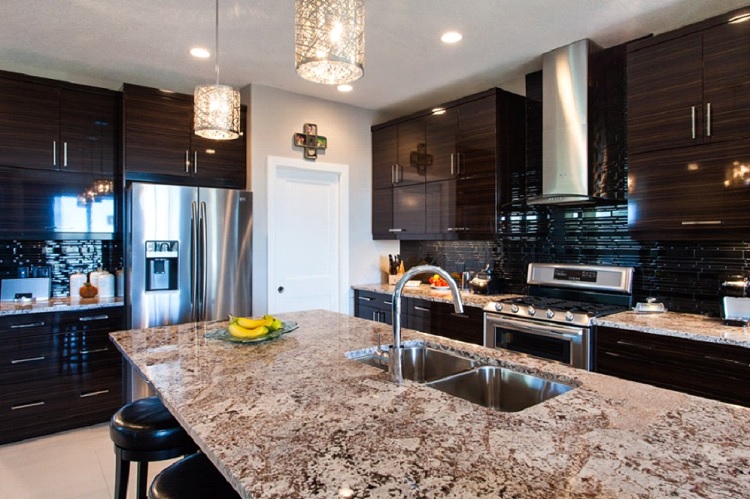How To Remove Stains From Your Granite Countertop
You’ve spent countless months considering your new kitchen remodel, days thinking about the advantages of granite countertops, and hours picking out the right design that fits just perfectly in your home; now you’ve been using your countertop for a few months and guess what, you found a stain. It might sound bad, but fear not! With some careful planning and a little bit of mad science, you can create your own solution to remove that unsightly stain from your granite countertop and bring it back to its clean and regal state.
Before we proceed, even before the planning stage, we must first ensure you truly are looking at a stain, and not damage.
Stained Granite versus Damaged Granite
What is the difference between a stain and damage? The first thing you should understand is damage does not necessarily mean a chip in the stone. Damage to the granite unfortunately means we need to get the granite countertop repaired. Stain removers will do nothing for damage.
Damage is specifically a change in the chemical or physical makeup of the granite. Such worn away, chipped, or torn areas of the granite countertop. Damage can also occur due to discolorations caused by acids, which eat away at the granite, leaving behind what appeared to be water spots, which is also known as acid etching.
Stains, on the other hand, are simply discoloration of the stone due to absorbing a staining agent, such as coffee, oil, that pesto spot you left on the counter for two days. Chemically, granite becomes stained when a solution containing a dissolved substance penetrates the granite surface and then evaporates, leaving the residue behind within the stone. Insofar as oil, or grease, it simply absorbs into the granite without evaporating, leaving a stain nonetheless.
The key thing here is that a stain is simply a foreign agent the granite reluctantly absorbed, whereas damage is a physical change in the granite itself. One can be cleaned, the other needs repairs.
If you are unsure, or unable to determine if you are looking at a stain or damage, we highly recommend you get professional advice before proceeding. Alternatively, if you don’t want to go through the trouble of making one yourself, K&J’s Custom Granite’s showroom stocks pre-made poultices for various stains.
So, you have determined it is a stain, well now it’s time for some mad-science!
Mad-Science: The Poultice
First, you need to create a compound called a poultice. Also known as a cataplasm, a poultice is a porous solid filled with a specific solvent that is used to remove stains from porous stone such as marble or granite. Exactly what we need.
Poultice is a two-part ingredient. For part one, we need a porous material. Here are some options for creating the base of our poultice; the porous material:
- Talcum powder
- Paper (mache)
- Whiting powder
- Diatomaceous earth
- Folour
- Limestone
The second part of the poultice is the solvent, which is a specific chemical used to treat very specific types of stains. What solvent you need will depend on the following:
- Stain: Organic stains, such as tea, ketchup, coffee, pesto, etc
Chemical Solvent Needed: Hydrogen Peroxide - Stain: Inorganic (ink, dyes, marker, etc)
Chemical: Rubbing Alcohol or Hydrogen Peroxide - Stain: Oils
Chemical: Pure Acetone (do not use nail polish remover!) - Stain: Biological stains, such as mold and mildew
Chemical: Bleach - Stain: Metal based stains, such as rust, or god forbid, mercury
Chemical: Iron-Out
Mixing The Poultice
You determined your type of stain and purchased the necessary ingredients, now it is time to whip out the lab coat and start mixing your poultice.
When mixing, you are looking for a thick paste, much like the putty you use to cover up holes in a wall. We suggest wearing latex gloves or dishwashing gloves to prevent any of the harsh chemicals from getting on your skin. It is also strongly suggested you mix in a well-ventilated area, and wear safety goggles and a paper filter mask. Safety will always be key when using any sort of chemicals. Use an old paint bucket if you have one.
Once your done your mix, you are ready to apply your poultice to the stain on your granite countertop.
Apply the poultice to the stained area, and only on the stain (try not to spread it around anywhere else), and it should be about a half a finger-width thick. Now wrap the area with plastic wrap to keep its moisture, and it allow it set for 24 hours. Once set, remove the plastic wrap and allow the poultice to dry completely before removal. It could take hours to days for this stage, so be patient!
Now that the poultice is dry, use a plastic (not metal!) scraper to remove the poultice from the surface of the granite and whip the countertop with a clean cloth to remove any remaining poultice. Feel free to clean the area as you normally would with light soap and water.
If the stain is not fully removed, you may need to reapply and follow the steps above.



